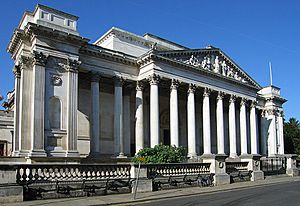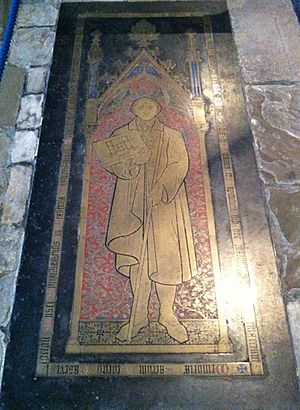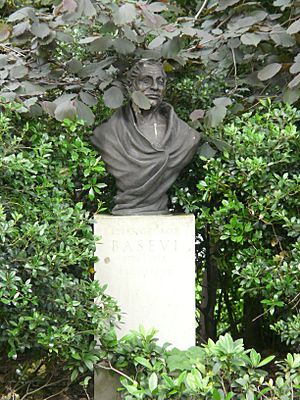George Basevi facts for kids
Elias George Basevi (born April 1, 1794 – died October 16, 1845) was a British architect. He designed buildings in two main styles: Neoclassical (like ancient Greek and Roman buildings) and Gothic Revival (like old churches and castles). He learned from a famous architect named Sir John Soane. Some of his most well-known designs include Belgrave Square in London and the Fitzwilliam Museum in Cambridge. He also worked as a surveyor, inspecting buildings for an insurance company and for some important estates.
Contents
Who Was George Basevi?
George Basevi was born in London in 1794. His family had a Jewish background. He went to school in Greenwich and then trained to be an architect with a famous teacher, John Soane. After his training, he spent three years studying old buildings in Greece and Rome.
In 1821, he became the first surveyor for the Guardian Assurance Company. He kept this job until he died. His work involved checking buildings that were very risky or insured for a lot of money. He also redesigned their offices in Lombard Street, London.
Early Church Designs
In 1822, Basevi designed St Thomas' Church, Stockport. The next year, he designed St Mary's in Greenwich. Both churches were built for a group called the Commissioners of the Church Building Act. These churches were in the Neoclassical style.
Basevi was not happy with changes the Commissioners made to his designs, especially for the church steeples. Because of this, he did not work for them again. St Mary's Church was later taken down in 1936.
Designing Famous Buildings
Belgrave Square
Basevi designed Belgrave Square in London for developers William and George Haldimand. This large square with grand houses was built between 1825 and 1841. Its success led to more important jobs for Basevi.
He became the surveyor for the Smith's Charity estate in Brompton and the nearby Thurloe estate. At first, his tasks were practical, like checking existing buildings. But in 1832, some land became available for new buildings. Between 1833 and 1845, he worked with a builder named James Bonnin. Together, they developed areas like Pelham Crescent, Pelham Place, and Egerton Crescent. He also designed the houses in Thurloe Square for the Thurloe estate.
The Fitzwilliam Museum

In 1835, Basevi won a competition to design a museum for Cambridge University. This museum was funded by a gift from Viscount Fitzwilliam. Basevi's design was grand and in the Corinthian style, which is a type of Neoclassical architecture.
Work on the Fitzwilliam Museum continued after Basevi's death. Another architect, C. R. Cockerell, finished the project.
Other Important Projects
Basevi also designed several Gothic churches. These included St Jude and St Saviour in Chelsea, and Holy Trinity in Twickenham Green. In 1834–36, he largely rebuilt St Andrew's Church in Hove, which had been in ruins. The church at Eye in Northamptonshire was also rebuilt using his designs. It opened in 1847, after his death.
He used the Gothic style for other buildings too, like almshouses (homes for poor people) in Stamford and Ely. He also worked on Balliol College, Oxford, designing a Gothic ceiling for their chapel. He was asked to design a whole new front for the college, but these plans were not carried out.
Basevi worked on many other projects. He designed stables at Bretton Hall in Yorkshire and Bywell Bridge in Northumberland. He also remodeled Gatcombe Park and made changes to the Middlesex Hospital. He built a new medical school and operating theater there. In 1834, he designed Beechwood House for his brother. He also enlarged the prison at Ely and built a new one at Wisbech.
With another architect, Sidney Smirke, he designed buildings for the Conservative Club. They were also chosen to design a new building for the Carlton Club, but this plan was delayed.
His Legacy
Basevi became a Fellow of the Royal Society in 1843. This is a special honor for important scientists and scholars.
He died on October 15, 1845, when he was 51 years old. He fell through an opening in the bell chamber of the west tower of Ely Cathedral while checking repairs. He was buried in the cathedral.

A special blue plaque in London remembers Basevi at 17 Savile Row.
Basevi's sons became army engineers. His older son, George Henry, became a colonel and was interested in microscopy. His younger son, James Palladio Basevi, was an army engineer who died in the Himalayas while measuring gravity.



